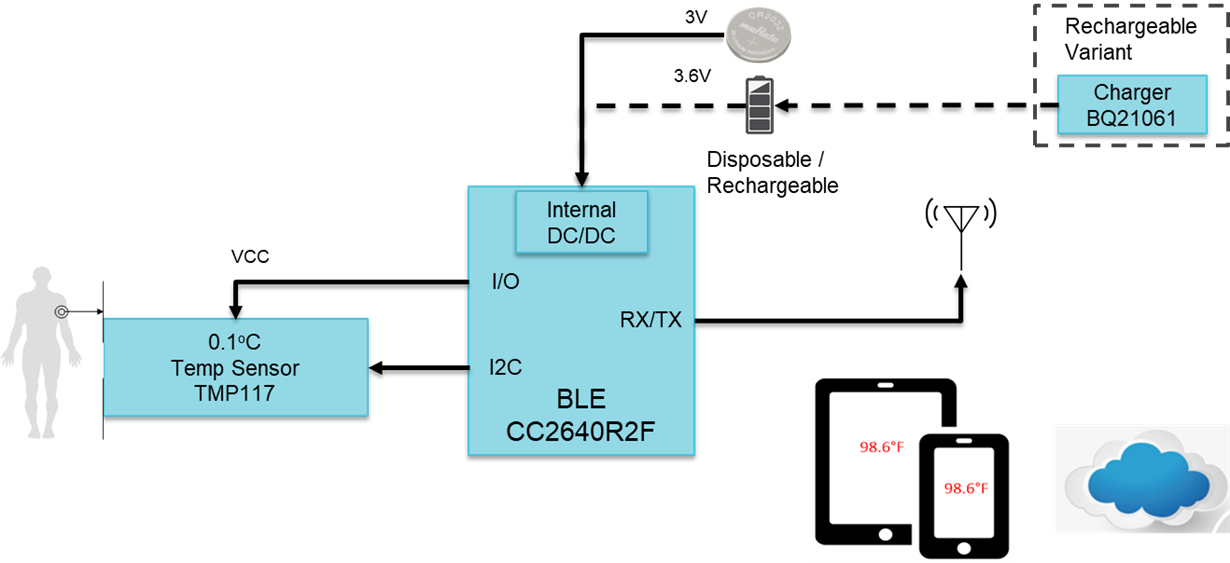Other Parts Discussed in Thread: BQ21061, TMP117
Wearable temperature patches are emerging in patient temperature-monitoring systems. One of the biggest hurdles in designing these patches for use in a clinical setting is to meet the stringent accuracy requirements.
The American Society for Testing and Materials (ASTM) specifies electronic patient thermometer accuracy requirements as shown in Table 1. In the most stringent range, these standards allow a maximum error of ±0.1oC to ensure an accurate measurement of a patient’s temperature.
|
Temperature (°C) |
Maximum error (°C) |
|
< 35.8 |
±0.3 |
|
35.8-37.0 |
±0.2 |
|
37.0-39.0 |
±0.1 |
|
39.0-41.0 |
±0.2 |
|
> 41.0 |
±0.3 |
Table 1: Requirements for temperature accuracy under ASTM E1112-00(2016)
Beyond selecting an accurate temperature sensor, achieving true ±0.1°C accuracy in a clinical temperature probe or a wearable temperature patch can be challenging for the following reasons:
- Low power: At this level of accuracy, even transient power consumption on the order of microwatts (µW) can be enough to heat a sensing element outside of the ASTM E1112 required range.
- Thermal design: As a designer, even after you’ve calibrated and verified the overall accuracy of your system, it’s still possible for external environmental factors to affect the sensor or measurement, such as physical shock or a change in pressure, to cause the thermal path to be less conductive due to loss of contact with the skin, resulting in a loss of accuracy.
In this post, I’ll discuss the block diagram for wearable temperature monitoring systems, and share challenges for thermal designs.
Reference System Block Diagram
Figure 1: Reference system block diagram for a wearable temperature patch
In many cases, a disposable temperature patch system consists of a coin cell battery, connected MCU and temperature sensor. However, in a rechargeable variant, the system also includes a battery charger as shown in Figure 1. For wearable patches, the battery can be flexible, so the patch can stick properly to the patient’s skin.
One of the key design challenges is to guarantee high measurement accuracy while maintaining a small physical profile for patient comfort. Using highly integrated devices enables a slim temperature patch profile for improving patient comfort. The key devices selected for this system to meet the key requirements are TMP117, CC2640R2F and BQ21061 (for rechargeable variant). Their description is shown below.
The TMP117 is a high-precision digital temperature sensor. It is designed to meet ASTM E1112 and ISO 80601 requirements for electronic patient thermometers. The TMP117 provides a 16-bit temperature result with a resolution of 0.0078°C and an accuracy of up to ±0.1°C across the temperature range of -20°C to 50°C with no calibration.
The SimpleLink™, Bluetooth® Low Energy CC2640R2F is a wireless microcontroller (MCU) targeting Bluetooth 5.1 Low Energy (LE) applications. The low active RF and MCU currents and low-power mode current consumption can provide excellent lifetime for energy-harvesting applications or applications that require small batteries. Available in 4x4, 5x5 and 7x7 QFN packages, the CC2640R2F also integrates a DC/DC converter to simplify battery-powered designs.
The BQ21061 is a highly integrated battery charge management IC that integrates the most common functions for wearable, portable and small medical devices, namely a charger, regulated output voltage rail for system power, LDO and push-button controller. The BQ21061 IC integrates a linear charger with PowerPath that enables quick and accurate charging for small batteries while providing a regulated voltage to the system. The push-button controller can help achieving ship-mode feature for the wearable patches.
Some more important aspects of selecting a sensing element (thermistor or integrated circuit temperature sensor, challenges in designing for minimal temperature like sensor’s thermal contact with patient and isolation from other heat sources etc. are discussed on our blog Design considerations for a wearable temperature monitoring system
Conclusion
Medical accuracy for patient temperature monitors poses some difficult thermal challenges. With the right sensor, you can overcome these difficulties with an understanding of how to take advantage of the placement and layout of your system.
Additional resources
- Check out the TMP117M, TI’s ultra-high-accuracy ±0.1°C temperature sensor for medical applications.
- Jump start your design with the “Bluetooth-Enabled High Accuracy Skin Temperature Measurement Flex PCB Patch” reference design.
- Read more about temperature patch design in these application notes:
- Watch the “Wearable, wireless, multiparameter patient monitor for medical” video about TI’s wearable temperature patch design.
- Check out the Medical Sensor Patch application page


